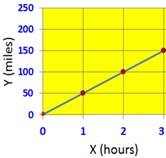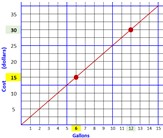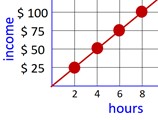|
Determine the constant of proportionality (k = y/x) |
|
|
|
|
Objective: |
Show/Hide |
|
The student will be able to find and interpret the constant of proportionality (k = y/x) within mathematical and real-world problems. |
|
|
|
|
Standards: |
Show/Hide |
|
7.4 Proportionality. The student applies mathematical process standards to represent and solve problems involving proportional relationships. The student is expected to:
7.4(C) Determine the constant of proportionality (k = y/x) within mathematical and real-world problems. |
|
|
|
|
Success Criteria: |
Show/Hide |
|
Find and interpret the constant of proportionality (k = y/x), from equivalent ratio tables, graphs, and word problems. |
|
|
|
|
Definition: |
Show/Hide |
|
A ratio table is a list of equal value (equivalent) ratios.
A Proportional Relationship is a direct variation between two variables. If one varies then another varies in proportion (the two variables always have the same ratio in relation to each other).
The graph of a proportional relationship is a straight line through the origin.
All proportional relationships are in the form Y=kX.
k is the constant of proportionality
(k is the ratio between two directly proportional quantities k = Y/X) |
 |
|
|
|
|
Mini Lesson: |
Show/Hide |
|
In our house we have a rectangular shaped patio and dad asked my brother and me to measure it. I measured the patio and its dimensions were 10 by 15 yards. The measurements my brother got were 30 feet by 45 feet.
Dad told us that we are really talking about the same thing, because the constant of proportionality that allows us to convert from Yards to feet is three, since for each yard there are 3 feet.
Dad told us that the constant of proportionality is also known as a unit rate, rate of change and slope, and that is obtained by dividing Y / X.
We can find the constant of proportionality in a graph or in a ratio table. The equation of the constant of proportionality is k=Y/X, so k corresponds to the value of Y when X is 1. |
 |
|
|
|
|
Constant of proportionality (k = y/x) in Daily Life: |
Show/Hide |
|
We often use the proportionality constants when we convert from one unit to another for example from hours to minutes, from kilometers to meters, from inches to centimeters, or from yards to feet.
When we load gasoline the price charged to us is proportional to the number of gallons we buy in this case the price per gallon is the constant of proportionality. |
|
|
|
|
Vocabulary: |
Show/Hide |
|
A variable can change its value over time.
A constant is a value that does not change.
The constant of proportionality k is the ratio between two directly proportional quantities (k = Y/X) |
|
|
|
|
Resources: (from MsGarciaMath) |
Show/Hide |
|
Scale Drawing |
Video |
|
Directly Proportional |
Video |
|
SF01 Scale_Drawing |
Worksheet |
|
SF05 Similar Figures_Missing Side |
Worksheet |
|
SF06 Scale_Perimeter |
Worksheet |
|
AR04 Scale_Area |
Worksheet |
|
|
|
|
Example Problems: |
Show/Hide |
|
The following chart shows the number of gallons against the price at a gas station.
Two points of the graph are marked with a red dot (6,15), (12,30)
Find the proportionality constant from the Graph (dollars per gallon). |
 |
|
|
Solution |
|
A car is traveling at an average speed of 60 miles per hour. The car travels 60 miles in one hour, in two hours travels 120 miles, and in 3 hours travels to 180 miles. We can write the equation Y=60 X, where y is the distance (in miles) and X the time (in hours). Find the constant of proportionality k=Y/X. |
Solution |
|
The amount of gas a car consumes is proportional to the number of miles travelled. If a car consumed 6 gallons of gas to travel 126 miles, how far the car can go with 1 gallon of gasoline? Write the equation that determines the number of miles the car can travel based on the number of gallons of fuel. |
Solution |
|
The graph shows the amount of money that dad earns in his job (depending on the number of hours he has worked). How much does he earn per hour?
What is the constant of proportionality for the line on the following graph? |
 |
|
|
Solution |
|
|
|
|
|